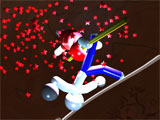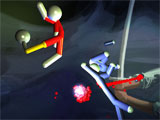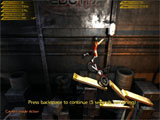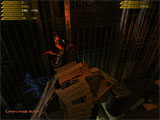Trio of Heroes Use Physics to Fight Undead
Trine is a physics-based platformer/brawler from independent Finnish developers Frozenbyte (best known for their Shadowgrounds series). In Trine you instantly swap between three different characters, each with a unique means of manipulating your physical surroundings. The wizard levitates objects and creates blocks/planks, the thief fires a grappling hook, and the knight tosses objects about. The skill of playing Trine well is learning to choose the right character to deal with different situations.
Physical Interactions
The gameplay in Trine breaks down into two major activities: Physical platforming, where the goal is to get from point A to point B, and brawling, where the goal is to defeat a number of enemies. Physical platforming is aided primarily by the wizard, who has the most direct control over physical objects. Many of the physical puzzle involve some kind of contraption–you jump onto a hanging platform and then use the wizard to move it forward, or you remove an object blocking a battering ram from swinging forward and breaking a wall. Sometimes simply creating and stacking boxes will get you up and over an obstacle.
Brawling in Trine is satisfying and well supported by amazing character animations. However, the fighting system isn’t very physical. I would have loved to see the physical platforming and brawling aspects intermingle more. You can kill enemies by throwing stuff at them, either with the knight or the wizard, but overall the enemies don’t interact much with the physics system (they just react to it). Much of their physicality actually stems directly from the animations; I suspect enemy interactions with solid-color bounding boxes would feel much less physical. By comparison, check out the well-integrated character/physics interactions in Hitlers Must Die!, where the characters really aren’t much more than bounding boxes to begin with.
Different Play Styles
One of the benefits of physics-based gameplay is the natural tendency for the game to support multiple play styles. Trine does this well, especially with multiple characters always available. The above video showcases this by having the same section traversed with different characters. Multiple solutions are always possible in any given choke point, depending on who you use. A player who prefers fast-paced movement will favor the thief and the grappling hook, while a more cautious player may try to stay on–or create–high ground with the wizard.
I enjoyed the sense of control I had over the game’s pacing. If I wanted to bang my head against the wall, trying to see if I could solve a puzzle in a particular way, I wasn’t hurried by the game itself. Or I could barge ahead with the thief, ignoring the level’s nooks and crannies (and the experience posts hidden within). However, Trine pulls the rug on this self-set pacing in its final level, with a very frustrating time pressure sequence. It’s like they completely ignored what made the preceding 4 hours so enjoyable and just wanted to prove they could give you something “hard” to play. Boo.
Production Values
Trine is a solid physics-based game. The physics themselves aren’t amazingly complex, and the possibility space of any one puzzle is more narrow than a straight physics puzzle game, but the overall experience more than makes up for it. Trine is a well-rounded blend of physics platforming and fighting. It’s also worth mentioning that Trine is a gorgeous game. I found myself continuing to play for the environments alone, just to see what was coming up next.
Download Trine Demo (470 MB, or download on Steam)
The full version of Trine is $29.99 and available on Steam. A PSN release is forthcoming. Keep an eye on the Trine homepage for more PS3 details!
Related Posts:
- No related posts
Nimble Ninjas Face Ferocious Foes
Rubber Ninjas is the 3D follow-up to Matteo Guarnieri’s excellent Ragdoll Masters. Ragdoll Masters is over 3 years old, now, and Rubber Ninjas does a great job of taking the simple ragdoll fighting system into a 3D space. It adds some graphical polish without sacrificing the elegance that made the first game so good.
The Third Dimension
The most obvious feature addition to Ragdoll Ninjas is that the fighting space is now 3D. From the player’s point of view its “3Dness” isn’t very important, though. Controls are always handled perpendicular to the camera–you can’t move in and out, just on the camera’s plane–and the camera will auto-rotate to position the nearest opponent on the same plane as your movement.
For control purposes, then, the gameplay is still essentially 2D. This can become confusing when the camera orbits quickly, though. Much of the gameplay strategy is maintaining angular momentum; an effective strategy is windmilling as much as possible. Because your “left” and “right” are relative to the camera, you need to compensate for camera orbits by alternating your input as the camera moves to the backside of your character to keep your windmill going.
Simplifying true 3D is a tricky problem to solve. Despite a few quirks, I think Matteo actually did a great job full 3D movement with a simplified 2D input system. I’m not sure offhand what I would do differently if I were to attempt the same!
Influencing, Not Controlling
The addition of full 3D movement means your ragdoll fighter spin in directions you cannot directly counteract. For instance, if you’re spinning towards the camera, you can’t immediately stop that spin (because you can’t directly move towards or away from the camera). The best you can do is begin a spin on the camera plane and hope the momentum transfers into your new direction before too long.
Because of this, playing Ragdoll Ninjas is something of a once-removed experience. You feel like you can merely influence your fighter. It’s very difficult to see an opening in your opponent and say to yourself, “Now! Kick his head! Kick it!“. Instead, you can influence your spin and try to get a good flail in his general direction. It’s quite different than some of the precision possible in a game like, say, Toribash.
The interesting side effect of this is the learning curve of Rubber Ninjas is somewhat obscured. I know I’m getting better at the game–the first few levels in each campaign are quite easy now–but I couldn’t tell you exactly what I’m doing different. The game is very much about tendencies. You learn to somehow have a tendency to keep your head away from their flailing limbs, while increasing the regularity of your flailing limbs being near their weak spots.


(Rubber Ninjas Game Screenshots)
Cinematic Goodness
The camera in Rubber Ninjas takes a lot of liberties in presenting the action from all sorts of different angles. Time is regularly slowed–or stopped for big hits–and it seems like the camera is constantly orbiting and tracking new opponents. This can be disorienting at first, but I think it’s actually a net positive. I’ve had some great Matrix-style camera orbits just as I manage to kick an opponent’s head off.
The result of all of this camerawork, and the game’s indirect controls, is that the player forms a very fluid relationship with their avatar. This is one of those games where a chance good encounter, like kicking off that head, makes you feel like you were somehow responsible for a perfect blow.
On the flipside, random hits that work against you never quite seem like your fault. It’s easy to say “Ugh, why did you just do that, rubber ninja man?!”, yet take the credit in the 1st-person when you do well.
If you’re looking for somewhat random ragdoll fighting action in glorious 3D, I believe your search stops here. Give Ragdoll Ninjas a look:
Download Rubber Ninjas Demo (19 MB, also available for Mac)
The full version costs $19.95 USD, and is available directly from Matteo’s site.
Related Posts:
- Rubber Ninjas Gameplay Teaser
- List of Physics Games
- Frustration Generator: Sprinky Physics Game
- Interview: Peter Stock, Armadillo Run
Trials 2SE Visual Upgrade, Same Great Physics
The original RedLynx Trials game was one of the games that spurred me to create Fun-Motion. Here was a game completely based on physics, with its own learning curve and style of play. It was relatively obscure, though, as were many other physics games back then, so I decided to start a site dedicated to these unknown gems.
RedLynx is still at it, and launched Trials 2 Second Edition on Steam in late May. They’ve come a long way since that first Java-based trials game. The core play remains the same–the physics-based fun and frustration both–but the presentation has been given a humongous face lift, and new features abound. This is one beautiful game!
For New Players
Trials 2 SE does a good job of bringing new Trials players up to speed. The previous games relied on the player to learn how to manipulate the bike’s spring rig to jump forward, jump upwards, and generally clear obstacles. This time around, RedLynx has included tutorial levels that explicitly state how to accomplish these maneuvers.
Controls remain the same, simple scheme: Up and down control throttle, and left and right change rider stance and apply rotation to the rig. The sophistication comes from the physics simulation itself. This is a game where tapping acceleration 50ms later may mean the difference between clearing the hill climb or completely failing it.
New Physics Possibilities
The collision engine in the previous RedLynx games relied on one unbroken ground object for collision. This mean you couldn’t both go over and under something, just over it. Trials 2 SE removes any of those restrictions. They use this new flexibility in a sensible, fun way. There are pipes you have to go through in a crouched stance, which limit your options beforehand, and some great loop-like structures.
Physics interaction is 2D, despite the 3D appearance. There are actually a handful of levels where physics objects in the level are dynamic. I would love to see more levels like this, because it makes the game easier and more forgiving. The static levels have very definite solutions, where an optimal runs will look very similar. On the levels with free-moving obstacles, though, things are more fuzzy, which I like. These levels do have a strange disconnect in that physical objects, like a crate or barrel, can actually move in 3D, while your rider is still fixed in a 2D plane.


(Trials 2: Second Edition Game Screenshots)
Frustration Generator
As in the previous games, Trials 2 Second Edition provides a lot of frustration. It takes a certain player to bash their head against a seemingly impossible incline again, and again, and again. RedLynx is very good at level design at this late point in the series. They understand perfectly how to craft a particular combination of slopes, obstacles, and jumps into a death trap. I often find myself cursing that if some tire were just a tiny bit farther from a jump, this would be an easy line. It’s designed that way, of course, which is actually what motivates me. If I felt like the levels were hard because of random placement, I would give up. It’s a dangerous game to pit yourself against designers like this, though, and particularly against designers as savvy as the ones who built these levels.
On the plus side, the high scores for each level also have a recording available. If you’re stuck on a level, or simply baffled as to how someone beat it in literally half your time, you can watch their replay or download it as a ghost to race head-to-head. The replays even show keyboard input highlighted, to give you clues on a player’s technique.
Definitely Worth the $10
Trials 2 SE is a great upgrade for the series. The difficulty progression is smooth, there are new levels with goals like timed wheelies, flip counts, and the enhanced graphics will help lower the barrier to entry for average gamers. Trials tracks robust online integration, too, with individual and team rankings, Steam achievements, and the ability to download new levels in-game (here is my profile, for the curious).
Download Trials 2 SE Demo (123 MB) [or Steam demo link]
The full version costs $9.99 USD, and is available directly from RedLynx or through Steam.
Related Posts:
- Trials HD Headed to Xbox 360
- Physics-Based Observable Motorcycle Trials
- The Beginning
- Hot Biscuit Flash Motorcycle Trials
- About


 (Rate this game! 42 votes, average: 4.02 out of 5)
(Rate this game! 42 votes, average: 4.02 out of 5)

 My name is Matthew Wegner, and this site is dedicated to physics games.
My name is Matthew Wegner, and this site is dedicated to physics games.